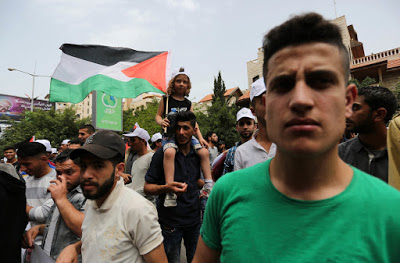Gaza’s economy is not ‘falling.’ It was pushed.
 |
| Marilyn Garson – September 27, 2018 |
The latest Economic Monitoring Report to the Ad Hoc Liaison Committee [AHLC] quantifies the collective punishment and mounting hardship of the Gaza Strip:
– 6% growth in the first quarter of 2018, compared to the same months of 2017.
53.7% unemployment, over 70% for youth and 78% for women in Q1, 2018. The first figures from Q2 suggest that unemployment has risen a further 5%.
53% of Gazans – every second person – lives below the poverty line.
2% of Gazans receive an uninterrupted supply of water. 98% do not.
The cause is not in doubt: the government of Israel imposes “restrictions that are the main impediment” to normal economic activity. “The blockade has caused Gaza’s economy to deindustrialize”. As proportions of GDP, manufacturing and agriculture have declined by more than half since 1994. The blockade and repeated wars have caused Gaza’s economy to grow more slowly than all of its comparator economies (including the West Bank).
And try doing business in an economy this volatile:
(Source: Economic Monitoring Report to the Ad Hoc Liaison Committee, September 27, 2018)
The structure of the problem explains Gazans’ vulnerability to the cuts made by Israel and Donald Trump this year. The blockade has strangled normal economic activity, such that the public sector is nearly all that remains. Rather than being an economic actor, entrepreneurial Gaza has been reduced to being a recipient. Gaza has been “kept afloat by… transfers”, rather than trade. In 2014 (the most recent figures), the expenditures of UNRWA, the PA and Hamas roughly equalled Gaza’s GDP. Their activity was the only significant spending. This phenomenon will have become even more pronounced since the war.
As they were prevented from earning a living, Gazans increasingly needed assistance. Now 79% of Gazan Palestinians receive some form of assistance, compared with 15% of West Bankers. Aid represents up to 45% of poor Gazans’ income. The poorest, and those living in refugee camps, show the greatest drop in their household expenditures – and these indicators of escalating financial distress were compiled before the most recent cuts took effect.
Hardship is, at last, evident in the declining secondary school enrolments. Education has always been Gaza’s signature, and among wealthier Gazans, it remains so. Among the poorest, it is becoming impossible, or futile, to keep their children in school after they have reached working age – especially their boys. Last year, 13% fewer Gazan boys completed Grade 9 than girls.
(Source: Economic Monitoring Report to the Ad Hoc Liaison Committee, September 27, 2018)
The blockade forced Gazans into deep dependence on financial transfers rather than earned income. Since 2017, for reasons of politics, the transfers have diminished.
The PA’s monthly expenditures have fallen by nearly $30 million since 2016. Reconstruction funds, pledged at the Cairo Conference after the 2014 bombardment “have been drying up”, although most of the homes that were heavily damaged have not yet been replaced. Donald Trump has seen fit to precipitously defund UNRWA, and US development and project aid worth $50 – 60 million annually, has also been lost. Israel’s added restrictions at Kerem Shalom and in the fishing zone have “severely exacerbated” the losses of 2018, especially the availability of fuels.
It bears repeating that each choice to withhold funds is a choice that disproportionately punishes the poor. Add to Gaza’s economic free fall the “rapid collapse in humanitarian conditions”.
Gazans continue to lose their salaries by the thousand, ensuring that more people will be in urgent need of the very assistance that is being cut. The PA has eliminated 22,000 Gazans from its payroll (and 4000 West Bankers). UNRWA has begun to lay off staff, while the search continues for new funding to offset Trump’s withdrawal from American commitments.
Technology and start-up sectors offer a bit of light. Start-ups are notable for the youth (27.7 years on average) and presence of women (23%) among founders. There is no other good news.
Without significant investment or political change, the report foresees a 5% contraction of real GDP this year. The report also notes just how easily political steps could reverse the decline. “Ending economic isolation and easing the blockade” could lead to cumulative growth around 32% by 2025. Relaxing the dual-use restrictions could lead to 11% growth.
The report is a trove of current statistical information – and there it ends.
Although the Monitoring Report observes that “bold actions are needed by all parties”, it initiates none. It does not enquire beyond economics to economic justice. Politically, it urges Israel to loosen the blockade, and it recommends that the Palestinian factions establish “legitimate institutions” under PA leadership, to earn the donor states’ confidence.
The AHLC’s role and composition explain its limitations:
The Ad Hoc Liaison Committee (AHLC) serves as the principal policy-level coordination mechanism for development assistance to the occupied Palestinian territory (oPt). The AHLC is chaired by Norway and co-sponsored by the EU and the US. In addition, the United Nations participates together with the World Bank and the International Monetary Fund (IMF). The AHLC seeks to promote dialogue between donors, the Palestinian Authority and the Government of Israel.
Each AHLC report therefore reflects both Gaza’s compounding losses and the ineffectual global response. Israel is not pressured by describing the disaster. Gazan Palestinians’ living conditions are not eased by it, either.
In Gaza, one always fears that new losses will become the new normal. The report’s annex validates that fear. It features a table, summarizing the progress made on its 42 current recommendations. Half of the recommendations show “no progress” in the past two years, and only four are “on track”.
Meanwhile, on the fields, near the fence, Gazans are being killed and their deaths risk being subsumed into the new normal.




